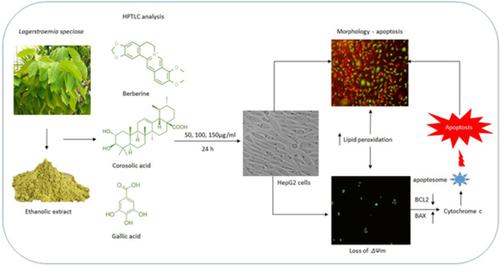当前位置:
X-MOL 学术
›
Environ. Toxicol.
›
论文详情
Our official English website, www.x-mol.net, welcomes your feedback! (Note: you will need to create a separate account there.)
Lagerstroemia speciosa (L.) Pers. triggers oxidative stress mediated apoptosis via intrinsic mitochondrial pathway in HepG2 cells
Environmental Toxicology ( IF 4.5 ) Pub Date : 2020-07-22 , DOI: 10.1002/tox.22987 Rohit Singh Thakur 1, 2 , Ezhilarasan Devaraj 2, 3
Environmental Toxicology ( IF 4.5 ) Pub Date : 2020-07-22 , DOI: 10.1002/tox.22987 Rohit Singh Thakur 1, 2 , Ezhilarasan Devaraj 2, 3
Affiliation

|
Hepatocellular carcinoma is the second leading cause of cancer‐related mortality worldwide. Lagerstroemia speciosa Pers. (Lythraceae) commonly known as Banaba has been used in different forms in traditional medicinal systems for treating various diseases which include diabetes and obesity. In this study, we investigated the cytotoxic potential of ethanolic Banaba leaf extract (EBLE) in HepG2 cells. The phytochemical analysis of EBLE was performed by HPTLC. HepG2 cells were treated with EBLE at 25, 50, 100, and 150 μg/mL concentrations, and cytotoxicity was evaluated by MTT assay. Oxidative stress was assessed by the evaluation of lipid peroxidation, superoxide dismutase, and reduced glutathione. Apoptosis‐related morphology was investigated by acridine orange and ethidium bromide (AO/EB) dual staining. Mitochondrial membrane potential (ΔΨm) was evaluated by JC‐1 staining. Apoptosis‐related marker genes were evaluated by qPCR. HPTLC analysis confirmed the presence of corosolic acid (12.87 μg/mg), berberine (3.19 μg/mg), and gallic acid (2.94 μg/mg) in EBLE. EBLE treatments caused significant and concentration‐dependent cytotoxicity and oxidative stress in HepG2 cells. Dual staining with AO/EB confirmed membrane distortion and nuclear chromatin condensation upon EBLE treatments. JC‐I staining revealed the loss of ΔΨm. Furthermore, at a molecular level, EBLE treatments interfere with Bax/Bcl‐2 homeostasis and induced the pro‐apoptotic marker genes such as cytochrome c, Apaf‐1, and caspases 9 and 3. EBLE treatments caused cytotoxicity in HepG2 cells, and this could be due to the induction of oxidative stress and apoptosis via the intrinsic or mitochondrial pathway.
中文翻译:

Lagerstroemia speciosa (L.) Pers。在 HepG2 细胞中通过内在线粒体途径触发氧化应激介导的细胞凋亡
肝细胞癌是全球癌症相关死亡的第二大原因。紫薇。(Lythraceae) 通常被称为 Banaba,已在传统医学系统中以不同形式用于治疗各种疾病,包括糖尿病和肥胖症。在这项研究中,我们研究了乙醇巴纳巴叶提取物 (EBLE) 在 HepG2 细胞中的细胞毒性潜力。EBLE 的植物化学分析通过 HPTLC 进行。HepG2 细胞用 25、50、100 和 150 μg/mL 浓度的 EBLE 处理,并通过 MTT 测定评估细胞毒性。通过评估脂质过氧化、超氧化物歧化酶和还原型谷胱甘肽来评估氧化应激。通过吖啶橙和溴化乙锭 (AO/EB) 双染色研究细胞凋亡相关的形态。通过 JC-1 染色评估线粒体膜电位 (ΔΨm)。通过qPCR评估凋亡相关标记基因。HPTLC 分析证实了 EBLE 中存在科罗索酸 (12.87 μg/mg)、小檗碱 (3.19 μg/mg) 和没食子酸 (2.94 μg/mg)。EBLE 治疗在 HepG2 细胞中引起显着的浓度依赖性细胞毒性和氧化应激。AO/EB 双重染色证实了 EBLE 处理后的膜变形和核染色质凝聚。JC-I 染色显示 ΔΨm 丢失。此外,在分子水平上,EBLE 治疗会干扰 Bax/Bcl-2 稳态并诱导促凋亡标记基因,如细胞色素 c、Apaf-1 以及半胱天冬酶 9 和 3。EBLE 治疗会导致 HepG2 细胞的细胞毒性,
更新日期:2020-07-22
中文翻译:

Lagerstroemia speciosa (L.) Pers。在 HepG2 细胞中通过内在线粒体途径触发氧化应激介导的细胞凋亡
肝细胞癌是全球癌症相关死亡的第二大原因。紫薇。(Lythraceae) 通常被称为 Banaba,已在传统医学系统中以不同形式用于治疗各种疾病,包括糖尿病和肥胖症。在这项研究中,我们研究了乙醇巴纳巴叶提取物 (EBLE) 在 HepG2 细胞中的细胞毒性潜力。EBLE 的植物化学分析通过 HPTLC 进行。HepG2 细胞用 25、50、100 和 150 μg/mL 浓度的 EBLE 处理,并通过 MTT 测定评估细胞毒性。通过评估脂质过氧化、超氧化物歧化酶和还原型谷胱甘肽来评估氧化应激。通过吖啶橙和溴化乙锭 (AO/EB) 双染色研究细胞凋亡相关的形态。通过 JC-1 染色评估线粒体膜电位 (ΔΨm)。通过qPCR评估凋亡相关标记基因。HPTLC 分析证实了 EBLE 中存在科罗索酸 (12.87 μg/mg)、小檗碱 (3.19 μg/mg) 和没食子酸 (2.94 μg/mg)。EBLE 治疗在 HepG2 细胞中引起显着的浓度依赖性细胞毒性和氧化应激。AO/EB 双重染色证实了 EBLE 处理后的膜变形和核染色质凝聚。JC-I 染色显示 ΔΨm 丢失。此外,在分子水平上,EBLE 治疗会干扰 Bax/Bcl-2 稳态并诱导促凋亡标记基因,如细胞色素 c、Apaf-1 以及半胱天冬酶 9 和 3。EBLE 治疗会导致 HepG2 细胞的细胞毒性,



























 京公网安备 11010802027423号
京公网安备 11010802027423号